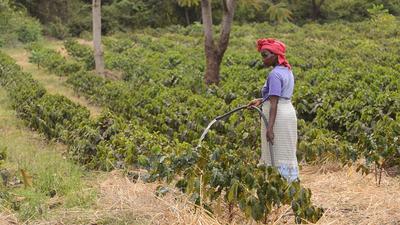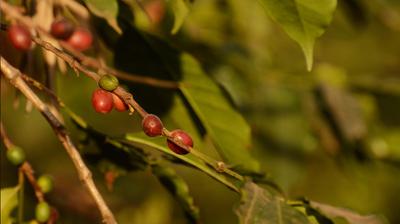Arabica coffee thrives only where average temperatures fluctuate from 64 to 70 degrees F annually.
Scientists who study the impact of climate change on the world’s coffee crop say agronomists must urgently research which of the world’s roughly 125 known coffee species might be able to survive in a hotter world. At this point, it appears that two of the most commonly planted coffee species, Arabica and Robusta, are unlikely to fare well as global temperatures continue to rise.
Coffee is the world’s second-most valuable commodity in trade, after oil. Hundreds of millions of people drink a total of more than 2 billion cups of brew made from the bitter bean every day. And about 20 to 25 million family famers earn part of their income growing coffee, according to the World Bank.
Tanzania is a relatively small player in coffee commerce — 13th in bags shipped — but coffee plays an important role in the nation’s tiny economy. The bean (actually the seed of the cherry) is Tanzania’s third-largest agricultural export, after tobacco and cashews, generating $162 million a year.
Coffee trees are highly sensitive to temperature and rainfall patterns. Arabica coffee — the most lucrative species, making up 70 percent of Tanzania’s production and accounting for about 60 percent of global production— thrives only where temperature fluctuations are small, with an average of about 64 to 73 degrees F annually. Arabica needs generous rainfall (or the equivalent in irrigation water) — about five feet a year. And it requires two to four months of dry weather between wet periods. Few places on earth meet these needs.
Robusta coffee, a less prized species used mostly for flavorings and instant coffee, can withstand higher temperatures, but needs more water and more stable temperatures between seasons.
According to a 2015 paper in the journal Agricultural and Forest Meteorology, conditions for growing Arabica in northern Tanzania — where Mt. Kilimanjaro and other uplands are located — have progressively worsened over the last five decades. The paper focused on the coolest temperature of the day, during the night. Other crops, including maize, soy, and rice, have been found to suffer disproportionately from increased nighttime temperatures, though scientist don’t know why. From 1961 to 2010, nighttime temperatures in Tanzania’s northern coffee-growing region increased by about 2.5 degrees F, the paper said.
Suzana Mbwambo, chief of Crop Productivity and Quality Improvement for TaCRI, the Tanzania Coffee Research Institute, says warmer temperatures have made the lower elevation bands of Tanzania’s highlands, roughly where Mushi’s farm is located, “no longer suitable for coffee production.”
Based on temperature forecasts, Craparo — lead author of the paper — predicts that by 2030 Arabica orchards in Tanzania’s highlands will be only one-third as productive as they were in 1960. By 2060, Arabica will be nearly impossible to grow, he says. Rainfall has dwindled slightly since 1960, but Craparo says so far the effect has been minimal. Moreover, he doubts changes in precipitation will have much impact on coffee harvests in the next several decades.
In principle, farmers could move to higher elevations where temperatures remain sufficiently cool. Today, coffee is grown on the flanks of Mount Kilimanjaro up to 6,000 feet, far below its 19,341-foot summit. There’s potentially suitable unoccupied land there and elsewhere in Tanzania’s highlands. But new farms would encroach on biologically significant forested parks harboring wildlife such as buffalos, bushbabies, and monkeys. Goodsteven Maro, a soil scientist at TaCRI says that in the future, farmers will be gradually squeezed between the steadily rising zones suitable for coffee cultivation and the protected Kilimanjaro park.
The problems facing coffee growers are now global in scope. Earlier this year, a paper in the journal Climatic Change forecast “decreases in suitability” for 90 percent of the land where coffee is raised in Nicaragua by mid-century; coffee currently accounts for 13 percent of Nicaragua’s exports.
These and other coffee forecasts anticipate the future by identifying areas where, based on climate models, temperature will be suitable for Robusta and Arabica coffee. They rarely take into account rainfall. That’s hard to predict accurately in small regions and impossible at present on a global scale. Aaron Davis, a botanist at Kew Gardens in London, one of the world’s leading plant research and conservation centers, says the results of different precipitation projections are so far apart that, when graphed together, “it’s more like an abstract art work.”
Estimates of future coffee harvests also generally fail to take into account possible changes in crop diseases and pest infestations, though experts say the impacts could be devastating.
Insects are highly sensitive to temperature. If it’s too cold, they can’t reproduce. Within the temperate range in which they thrive, they multiply faster, and cause more damage when it’s warmer. But it’s difficult to anticipate specifically how pests will respond to warmer weather, because their behavior depends also on the range of hosts and predators that feed on them, all of which also could change.
The world’s most destructive coffee pest, the coffee berry borer, has begun invading territories that were previously too cool for the bugs. A sesame seed-sized beetle, the berry borer burrows into the cherry and lays eggs inside the bean. Serious infestations can destroy one-third of a harvest. On Mount Kilimanjaro, the upper elevation at which berry borers live has risen by roughly 1,000 feet since 2000, exposing more farms to the insect. New infestations attributed to warming have been reported in Ethiopia. One of the few forecasts of coffee pests, a study of the berry borer in East Africa, predicts that by 2050, the insect will be “particularly damaging in current areas of high quality C. Arabica coffee production.” The paper warns, globally, of “grave implications for the coffee industry.”
More than 90 percent of Tanzania’s coffee is grown by small farmers who usually own less than a hectare (2.5 acres) of land. They’re mostly poor. According to one survey, one-third don’t own a radio; a bicycle is a luxury for almost all. Emanuel Mbise, a middle-aged father of 11 children, owns 700 trees on the slopes of a small, extinct volcano overlooking the town of Kikatiti, in northern Tanzania. He said that the late arrival of this season’s “short rain” had him worried and that a drought threatened to desiccate embryonic flowers that had sprouted. But a sprinkle that morning had given him “motivation.”
Mbise earns most of his income selling Arabica coffee. The crop early this year was poor; he harvested only 235 pounds of beans, far below the 2,200 pounds he reaps in good years. Such poor years have become more common since his youth, he says. Rainfall is less reliable, reducing the likelihood of a good harvest. He fears that the deterioration will continue, making the “conditions terrible in the future.” But he can’t see how else to earn cash for school fees and store goods. “We’re farmers,” he said. “There is no other way to access money.”
Davis, the Kew Garden botanist, calls predictions of coffee’s demise overblown. “Clearly there’s cause for concern,” says Davis, who leads the institution’s coffee research program. “Climate change is already impacting coffee in a big way.” However, Davis says that a “diverse portfolio” of adaptation measures could save the beverage, the crop, and the famers that grow it. Encoded in the genes of some coffee species could be the capabilities for growing under the conditions of 2050 or beyond. Many of these ignored species are drought-tolerant, he said. Before they could be raised commercially, of course “they have to be acceptable to the consumers,” a requirement that will require extensive research. Davis pointed out that coffee preferences have changed before. “The coffee-growing landscape of the world has changed even in the last 100 years, and it will change in the next 50 years,” says Davis.
With funding from the U.K., Denmark, and Norway, Davis is studying ways for Ethiopia’s coffee producers to respond to warming. Several years ago, he published a paper predicting that by 2080 indigenous Arabica might be unable to grow in Ethiopia, which contains a large swath of the species’ native habitat. He predicted a “profoundly negative” future for cultivated Arabica in Ethiopia, which is responsible for up to a third of the country’s export earnings. Creating new strains of trees could take decades, and there isn’t much time to spare. “We’re already 20, 30 years into climate change and nothing has happened,” said Davis.
Maro, the soil scientist at TaCRI headquarters in Tanzania, said that his colleagues are testing a new line of drought- and temperature-tolerant Arabica coffee trees that “survived where others had not.” Whether they could withstand the conditions that Tanzania farmers will face in 2050 remains to be seen.




